AMD Radeon HD 6850 Overclocking Roundup: Asus, XFX, & MSI
by Ryan Smith on November 8, 2010 12:40 AM ESTPower, Temperature, & Noise
With the variety of card designs it’s the difference in power draw, heat dissipation, and acoustics that truly separate the cards. It’s not just the difference in physical designs that helps set these cards apart, but also how the manufacturer has decided to tune the cards to balance these attributes. A balanced card is usually the most desirable.
| Radeon HD 6850 Load Voltage | |||||
| Ref 6850 | XFX 6850 | MSI 6850 | Asus 6850 | ||
| 1.094v | 1.148v | 1.148v | 1.148v | ||
As we noted in the introduction, all of our 6850s except the reference card have a load voltage of 1.148v, versus 1.094v. We’re still trying to get to the bottom of the issue, but in the meantime this means all of these cards run worse than the reference 6850 when it comes to power consumption.
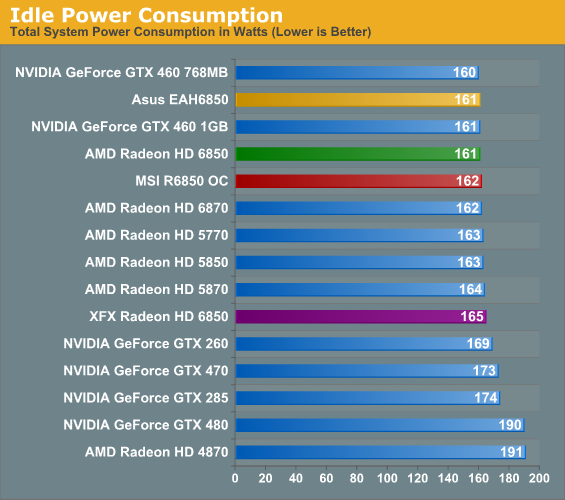
Out of our 3 partner cards and our reference card, our idle power results are tightly clustered among all of the 6850s except for the XFX card which draws a few more watts at idle. We believe this is due to XFX’s fan choice, though we can’t rule out component selection either.
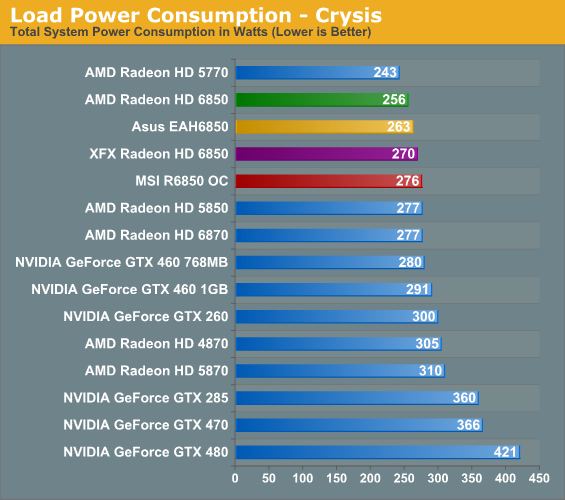
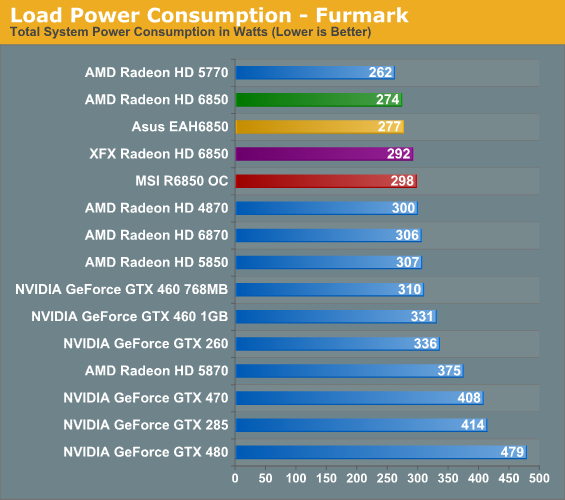
In terms of power consumption the Asus card is closest to the reference 6850, followed by the XFX and then the MSI card. This isn’t particularly good for XFX here, as the other partner cards all have at least a token overclock while the XFX card is doing notably worse than the 6850 reference cards even though it’s operating at the same clockspeeds. Even compared to the Asus card it’s doing worse here.
Meanwhile the MSI R6850 ends up being rather close to the 5850. Given that it achieves 5850-like performance, this isn’t particularly surprising.
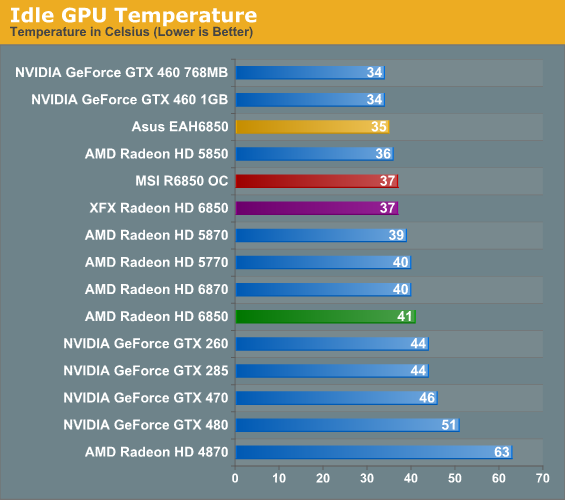
All 3 partner cards do better than the 5850 when it comes to idle temperatures thanks to their open designs. The price of a fully exhausting design is more noise and higher temperatures, which the reference 6850 pays the price for here.
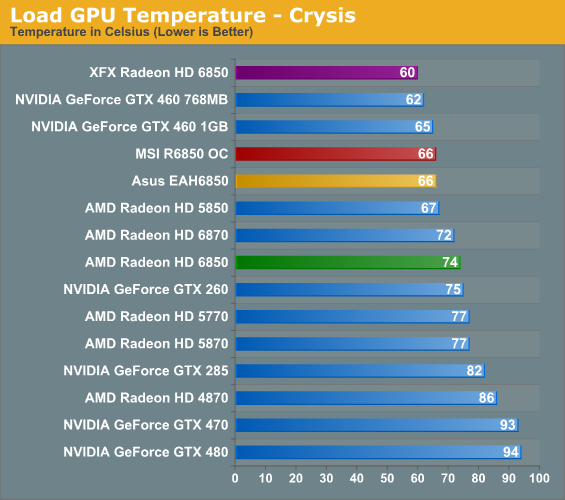
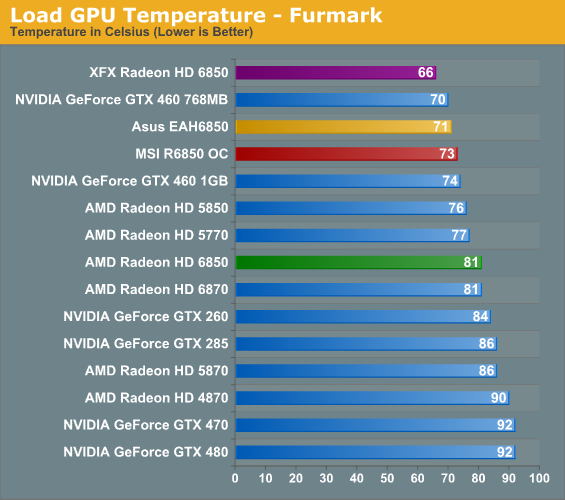
Once again the open coolers on the partner cards give them a significant leg up over the reference card. Even with the reference card’s lower power consumption, it runs hotter than all the open cards as we’d expect. Topping this chart is the XFX card, which with XFX’s extreme focus on cooling manages to hit only 60C on Crysis and 66C under FurMark. This is followed by the Asus and MSI cards, which are neck-and-neck, which is a reasonable outcome given the similarities between their coolers. All of the partner 6850s end up doing better than the NVIDIA GTX 460 1GB, which uses a cooler similar to the XFX card.
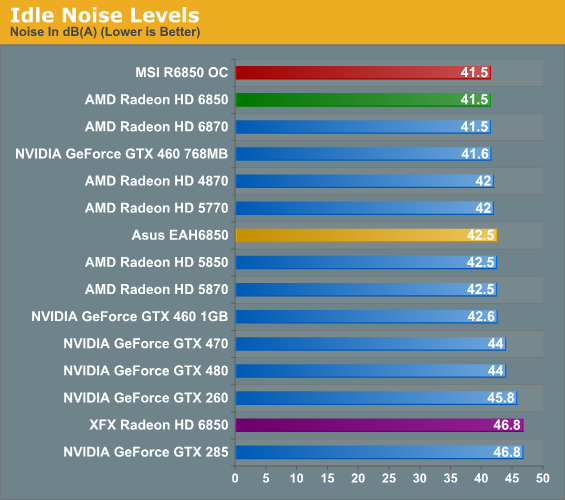
At idle most cards run up against our noise floor. The standouts here are the Asus card, which ends up being a dB over the quietest cards, while the XFX card does significantly worse here at 46.8dB. In practice the Asus card shouldn’t be any worse than the other cards, but the XFX is noticeable (but not distracting) at idle.

It’s when we move to looking at load noise that we see our 6850 cards significantly separate. The reference 6850 was a tough card to beat here being that it was tuned for noise, but Asus did it, coming in at 45.3dB, quieter than any reference card in its class. Meanwhile the MSI and XFX cards do significantly worse; the XFX at 59dB is outright loud, but this was a conscious design decision on XFX’s part to focus on cooling over noise concerns. MSI on the other hand has a card with similar temperature characteristics as the Asus card, but does significantly worse than the Asus card when it comes to noise. It’s difficult to do a straight comparison here, as while both cards have the same load voltage, the MSI card has a much larger overclock than the Asus card. The MSI card still seems too loud for what it is, even though the amount of noise is comparable to the 5850 and other cards with a similar power draw.










93 Comments
View All Comments
Mr Perfect - Monday, November 8, 2010 - link
AT normally tears the cooler off to examine the card, and then dissects the cooler itself too. Neither 6800 article has done this though. It should be an even bigger priority when we're comparing non reference cards that are competing purely on their unique designs. Are these cards on loan? Do they have to be returned in the same condition they where received? If so, I say just ship them back without reviewing them. :PI just came from XBitLabs, where they did a proper teardown of both a stock 6850 and 6870, and that Asus card looks a lot like the stock 6870 board. It has the two top mounted PCIe power connectors, and the VRMs appear to be between the GPU and IO ports. I would not be surprised if it really was a 6870 PCB. Check it out!
khimera2000 - Monday, November 8, 2010 - link
I appreciate the review, it looks alot less of a hot article as the last one, and its clear that a good amount of effert went into this article just by the comments AT left, and the way the article was written.I was also wondering when will the review of the higher end 6xxx card be availabe?
Cali3350 - Monday, November 8, 2010 - link
A lot of Doom and Gloom here about the OC cards. Let me try and tell you, Ryan and Anand, what I think the people want as a majority:1. Never use OC'd cards in a initial review. Ever. You guys, quite frankly, should have known this and the flak you are getting for using it is deserved imo. Nvidia conned you guys into making their cards unfairly better than the competition in the main review article of a major launch and you fell for it. That article will likely get much more readership than any roundup, and is likely to be looked up in higher numbers down the line. You played that one like a PR branch of Nvidia and you made people angry (imo rightly so). Dont ever do this again. Do not review anything but stock clocks in your GTX 580 review tommorow, and dont you dare use a overclocked anything in your upcoming Cayman review either.
2. Always use OC'd cards in your comparisons. This a COMPARISON article of AIB's and the products they are offering. Ofcourse we want to see how a overclocked 460 compares to a overclocked 6850, this is the article where we go over what is out there in the retail market, not what is officially supplied by the creators. This article loses a lot of value without a 460 OC'd in it.
Launch articles = what we are getting from the creators of the product.
Comparison articles = what we are buying in the real world.
I love this site, and I do not think your biased, but I wont defend you over the 68XX review either.
AnandThenMan - Monday, November 8, 2010 - link
I agree with what you are saying here. The problem is, the genie is out of the bottle. Anandtech should not let the 68xx review stand as is, the FTW results should be removed, and all references to it. And if that is not done, then overclocked AMD cards must be included in all future reviews, no exceptions. In fact, Anandtech should accept a hand picked, delivered to their door card from AMD.If neither are done, then I would question all results published here, there is a credibility problem to say the least. You can't start picking and choosing how reviews are done depending on the hardware. That is exactly why policies are in place. Sadly that policy was ignored.
Jamahl - Wednesday, November 10, 2010 - link
This.Ryan Smith and Anand deserve the fallout over this. They brought it on themselves as does any site that shifted their goalposts in the past few weeks.
Dwebtron - Monday, November 8, 2010 - link
I'm super interested in this one, as I'm holding on to mine... but it never appears in the charts?RaptorTek - Monday, November 8, 2010 - link
Its really the immature fanboys that cant handle seeing their company/card lose that make a stink about including the FTW OC cards in the mix. It makes them feel insecure about themselves and their decisions on being a fanboy for which they decided to spend their hard earned money on. When it comes down to it, the more data we have available the better the decisions we can make on what really is the best hardware for the price. Having the FTW 460 1gb in the stock 6850/6870 article was good since it showed what the contending cards possibilities were. Including the FTW 460 1gb in this OC article would of been even more relevant for side by side comparisons. I would hope Anandtech can see that even if some of "the readers" complain about these things, its really for the best in the logical comparison of these cards.
El_Capitan - Monday, November 8, 2010 - link
Indeed. Why would any logical person WANT LESS data?Fanboy: My HD 6850 that I bought for $189.99 is better than a stock GTX 460 1GB you purchased for $239.99, and overclocks higher!
Realist: I bought by GTX 460 1GB for $189.99 and it overclocks to 1015MHz without unlocking the voltage, what are you talking about?
Fanboy: AnandTech doesn't show that, so it's not relevant!
Realist: You're retarded.
Fanboy: You're an Nvidia fanboy!
Realist: I also own a HD 5870 2GB that I bought for $250.
Fanboy: Yeah, right, whatever!
Realist: ...
Fanboy: Stupid fanboys, they think they know everything.
Realist: :Facepalm:
AnandThenMan - Monday, November 8, 2010 - link
You both completely missed the point, and sounded childish and fanboy-ish in the process.jsrivo - Monday, November 8, 2010 - link
From what I've read, the OCed cards are reaching 800-900MHz on average, and claiming that 1015MHz is realistic for most buyers is a bit fanboyish, in my opinion.